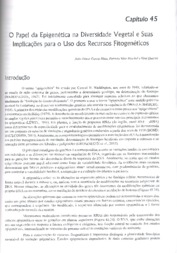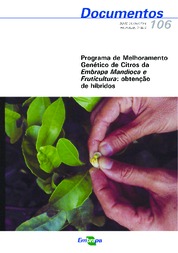Research stimulates citrus plants to adapt to drought
Research stimulates citrus plants to adapt to drought
Embrapa’s pioneer study takes advantage of the mechanisms of "memory" mechanisms developed by citrus plants to better adapt to water scarcity. The technique consists in subjecting the seedlings to water deficit during their formation. By receiving less water in this period, the plant develops a "memory" that will help it to face this reality as an adult. It occurs because the challenge imposed causes the so-called epigenetic changes in the plant, modifications in the genome that can remain stable throughout several cell divisions and do not involve change in the original DNA sequence.
The research evaluated the epigenetic alterations of two rootstocks (lower part corresponding to the plant's root system, to which a shoot is grafted), namely a red lemon tree and a 'Maravilha' sunki mandarin tree ones, in combination with the Valencia orange tree crown graft. These changes were induced by recurrent water deficit situations. The research is in the scope of a series of studies related to drought tolerance that Embrapa has been developing with several crops, such as cassava and banana, taking into account the gradual increase of climate change on the planet.
This is the first study that reports epigenetic alterations in citrus submitted to water deficit. There is similar research, but dealing with other crops. The results were published in Scientific Reports, a Nature group online journal.
Physiological, molecular and hormonal parameters were evaluated from the interaction between crown and rootstock, the two parts that make up the commercial citrus plant. "The idea is to carry out new experiments with other crown / rootstock combinations using this methodology. For this purpose, this study can be used as a pilot. The information obtained can be used in the development of a management technique with direct application in the citrus chain ", emphasizes Embrapa researcher Abelmon Gesteira, responsible for the study carried out in cooperation with the Graduate Program in Genetics and Molecular Biology of the State University of Santa Cruz (Uesc), in Bahia, Brazil, involving the students Diana Neves and Dayse Drielly Vieira, whose doctoral theses supported the research.
Diana, who studied the effects of recurrence of water deficit on plants, points out that the main innovation of the work lies in the perspective that the methodology developed can be used directly by growers. "The idea is that the plant growers can apply the water deficit during the formation of the seedlings themselves at the nurseries before taking them to the field. Then they will already reach the croplands with this 'memory' of drought tolerance," adds Diana, now a PhD in Genetics and Molecular Biology.
Three cycles of water deficit
The experiment was carried out at Embrapa Cassava and Fruits' citrus greenhouse. According to Gesteira, the red lemon and 'Maravilha' sunki mandarin rootstocks were chosen because they present different response behaviors to droughts. The selection of the Valencia orange was due to the fact it is the most widely planted orange variety in the world and that it is planted in big quantities in the state of São Paulo, the largest producer of citrus fruit in the country. The responses of the Valencia crown grafted on red lemon and 'Maravilha' sunki mandarin rootstocks were compared for three periods of recurrent water deficit .
A set of plants received only one cycle of water deficit, another received two, and the third one went through three cycles. Hence the differences between the material that received one cycle and those that received two and three cycles of water deficit were identified, ccording to Gesteira.
"In general, the Cravo lemon tree did not change much, as it already has a very good water extraction capacity, which ensures the growth of the plant. While in the case of the 'Maravilha' sunki mandarin, in the first deficit, the plants suffered a lot. Plants that received two and three water deficits improved their physiological responses to drought tolerance, with increased photosynthetic rates in the third cycle. The interesting thing is that 'Maravilha' sunki mandarin demonstrated that it ensured the survival of the plant, an effect due to its drought tolerance mechanism", the researcher emphasizes. And Diana adds: "Red lemon is a vigorous plant, it extracts a lot of water from the soil, like a pump. The 'Maravilha' sunki mandarin is slower to absorb water, as if it were saving water. It suffers at first, but then it adjusts itself. "
Gesteira also explains that, in the case of the Maravilha sunki mandarin, abscisic acid, which is known as "drought hormone", is synthesized in the roots and transported to the aerial part. "When it translocates to the aerial part, it controls the opening and closing of the stomata, then the plant closes the stoma and decreases the loss of water, managing to keep alive."
The researcher emphasizes the importance of similar studies. "We are in an increasingly complicated situation, not only in the semi-arid region. In São Paulo itself, the country's largest citrus producer, there is a period of intense water stress in the winter, which is cold but dry. The plants get no water for a period. So those that resist to water deficit will guarantee a better production. They feel it less and can last 3 to 4 months without water," he says.
New workGesteira says the question now is: does this memory of drought tolerance pass on to the next generations? That is, do the sprouts, the small offshoots taken from the branches of citrus fruit trees that produce seedlings, carry this memory? "The hypothesis is that the shoots from these plants that were challenged to tolerate drought have this memory in a stress condition. These mechanisms are what we call epigenetics, changes in the genome, such as methylation, which is a type of chemical modification that can be inherited without changing the original DNA sequence. We have already begun this study, a continuation of the first, with the shoots in the greenhouse and we will take them to the fields as well." The tests are part of the work by another doctoral fellowship student from Uesc, Andressa Sousa. On another front, Gesteira explains that, besides the shoots, he intends to work directly in the process of seedling formation. "The idea is to slightly stress the seedlings in their formation process and hence create epigenetic marks by methylation, for example, thus obtaining a more tolerant material. It's like a vaccine. You submit the plant to stress and see further ahead how it will behave in a water-deficient situation. The plant will feel it, but it is expected to feel less because it is better prepared for that situation," he explains. |
Translated by: Ana Maranhão Nogueira; Edited by: Mariana Medeiros
Alessandra Vale (MTb 21.215/RJ)
Embrapa Cassava and Fruits
Press inquiries
mandioca-e-fruticultura.imprensa@embrapa.br
Phone number: +55 75 3312-8160
Further information on the topic
Citizen Attention Service (SAC)
www.embrapa.br/contact-us/sac/



